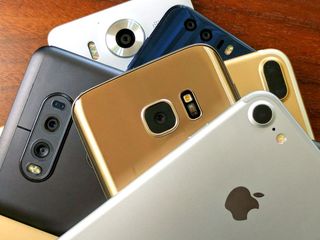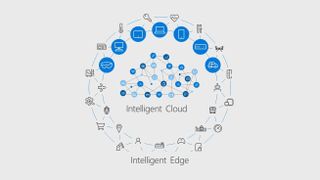What is Microsoft's intelligent edge and how does it affect mobile?
During Build 2017 Microsoft highlighted its intelligent cloud and intelligent edge strategy. But what exactly is the intelligent edge?

Microsoft's growing investments in cloud computing and a recent reorg reflecting those investments are sure to bring greater attention to Microsoft's intelligent edge and mobile strategy.
To understand the intelligent edge, however, we must have a basic grasp of the intelligent cloud and the Internet of Things (IoT).
Heads in the cloud
Cloud computing is using a network of remote servers hosted on the Internet, rather than a local server or personal computer, to store, manage, and process data. Simply put the Internet, or cloud has enabled computing that is no longer limited to a local hard drive but allows access to data and services that exist on other internet-connected devices.

Microsoft's OneDrive, OneNote, the online versions of Office, Google's productivity suite, Apple's iCloud and DropBox are examples of cloud-based products and services.
From a business perspective cloud offerings include Infrastructure-as-a-Service (IaaS), Platform-as-a-Service (PaaS) and Software-as-a-Service (SaaS).
- IaaS companies rent IT infrastructure such as servers, operating systems or networks on a pay-as-you-go basis, from a cloud provider like Microsoft.
- PaaS is ideal for web or mobile app developers who need an on-demand environment to develop, test, deliver and manage their software. The cloud provider manages the underlying infrastructure.
- SaaS is a means of providing software on-demand, over the Internet and is usually subscription based. The cloud provider manages upgrades, security and the underlying infrastructure. Users use Internet-connected devices like smartphones, PCs or tablets to access this software.
In conjunction with the cloud, the IoT is important to understanding edge computing. IoT is the interconnected array of computing devices, objects, and machines with unique identifiers that are capable of transferring data over a network without human-to-human or human-to-computer interaction. These devices include wearables, connected cars, smart home appliances and more. As devices which are closest to the user, they exist at the cloud's edge.
What is the Intelligent Edge?
The intelligent edge is the process where data is analyzed and aggregated at a point close to where it is captured in a network.
Get the Windows Central Newsletter
All the latest news, reviews, and guides for Windows and Xbox diehards.
Sam George of Microsoft's Azure IoT Team demonstrated (in video above) how logic for analysis of factory equipment that usually occurs in the cloud could be moved to a connected device onsite, on the cloud's edge.
This IoT Edge solution reduced latency associated with the transfer of data between the cloud and device.
During an April 2017, investors call Nadella shared his edge computing vision and alluded to its even more profound applications.
Everyone's talking about the cloud; the most interesting part is the edge of the cloud. Whether it's IoT… auto industry… retail, essentially compute is going where the data gets generated… which is the edge.[A] lot of what we have done with IoT is create an IoT edge... the ability to run a neural network at the edge, doing inferences at the edge is exciting.
Nadella said companies will eventually modernize their workloads by utilizing Microsoft's intelligent edge. He admits this is a long view that will endure a lot of market volatility as the industry transitions to increased edge computing:
It will also be modernized to live on the edge of the cloud. That's a multiyear and a generational transformation. Quarter to quarter, there will be all kinds of volatility. But… we have a very clear worldview of what is it that we want to get done.
Data, computational power and AI on the edge

Nadella stated at Build 2017: "We're moving from what is today's mobile-first, cloud-first world to a new world that is going to be made of an intelligent cloud and an intelligent edge." A user's experiences are being distributed across all devices. Within this context the multi-device experience now needs platform capabilities, he explained.
As more devices permeate our environment and become increasingly connected, more data is being generated at that clouds edge. Nadella gave an example of connected cars generating hundreds of gigabytes of data.
This amassing of data draws computational power to the edge enabling AI to process information and inferences to be made that were previously relegated to the cloud. Thus, an intelligent edge.
Intelligent surveillance, watching from the edge
Whereas George's demo showed the lower extreme of the intelligent edge, Microsoft's AI-driven surveillance tech demonstrates the higher extreme.
Using standard cameras such as those already in workplaces, hospitals, schools and communities Microsoft's AI enhanced surveillance solution can recognize people, places, things, actions and environmental conditions. In an initial deployment as a safety measure in workplaces and hospitals, it can also act proactively to convey information to appropriate personnel based on what it "sees."
AI-infused Internet-connected cameras that benefit from rich data collection, computational power, and powerful AI is just one example of an intelligent edge.
Dystopian abuse of Microsoft's powerful AI-driven surveillance tech is all but inevitable
Nadella envisions a world permeated with a diverse array IoT devices in homes, businesses, and communities that will comprise an intelligent edge. Microsoft's cloud investments are an attempt to position it for success in this coming shift to an ambient computing environment.
Smartphones on the edge

Like IoT and other cloud-connected devices smartphones are part of the intelligent edge. They also utilize various sensors to absorb a range of information about the environment they're in and the people who carry them. Limited AI and digital assistants use that data in conjunction with the cloud for various functions on behalf of users.
Like other devices that comprise the intelligent edge, the amount of data smartphones will be able to process will only increase with time. With this increase in data will come the resultant increase in computational power Nadella referred to, and the increased role and capacity of AI on mobile devices.
Microsoft's cloud strategy is positioning the company to provide not only the cloud backend for cross-platform products and services such as apps but also a cross-platform intelligent edge.
Microsoft demonstrated (above) the company's incorporation of iPhones, Windows, and Android phones as part of the Microsoft Graph with Cortana functioning as a cross-platform UI and a Windows 10 PC as a hub. This strategy allows users to begin tasks on their smartphone of choice and with the support of the Microsoft Graph and Cortana continue that task on a PC and vice versa.
Microsoft's strategy is an attempt to move as much of the industries products, services, apps and more to its intelligent cloud platform, Azure. It's also building out its intelligent edge by extending cloud-based services to an increasing array of devices like smartphones and incorporating them into a broad and encompassing strategy where they will exist on the edge of Microsoft's cloud.
The ultimate mobile and intelligent edge device
It will be interesting to see how Microsoft positions what Nadella calls an ultimate mobile device, or ultramobile Surface PC to take advantage of the cloud and intelligent edge infrastructure it is building. One would think Microsoft capable of (and strategically inclined to) building hardware and software that would work synergistically and uniquely with its evolving cloud and intelligent edge platform.

Without getting into a debate over semantics, what we call smartphones are more computers than they are phones. With defining and sought after specs such as processor speeds, storage capacities, RAM and more, descriptions of and selling points for smartphones are congruous with those of PCs. With phone calls ranking below web surfing, social media activity, messaging and more, mobile device usage is also more analogous with PC than phone usage. Smartphones are indeed computers that perform an array of functions via apps of which telephony (phone) is simply another function among millions.
With celluar PCs and selling mobile data through the Windows Store, Microsoft is showing signs of recognizing the dominant role of data on mobile devices and may be building a platform to bypass carriers and offer voice calls over the internet. Google with its mobile virtual network operator (MVNO), Project FI is doing just that. Microsoft which already has the internet voice and video calling asset of Skype may follow a similar strategy.
Living on the edge
I imagine Microsoft's long-term intelligent cloud and intelligent edge strategy, which Nadella concedes is generational (meaning it will take time) includes internet or cloud-connected cross-platform mobile devices where telephony is provided via data over the cloud.
When one views smartphones as the cloud-connected computers they are, the potential Surface phone as a Windows on ARM ultramobile PC, the evolution of cloud-connected tech and Microsoft's unrelenting cloud investments Microsoft's long play comes into view.

An intelligent edge that includes not only billions of IoT devices but also potentially hundreds of millions or billions of cross-platform mobile devices supported by Microsoft's graph, AI, and Cortana is Microsoft's goal. If Nadella honors his "best on Windows" promise Microsoft's ultimate mobile device just may have an edge.
Jason L Ward is a columnist at Windows Central. He provides unique big picture analysis of the complex world of Microsoft. Jason takes the small clues and gives you an insightful big picture perspective through storytelling that you won't find *anywhere* else. Seriously, this dude thinks outside the box. Follow him on Twitter at @JLTechWord. He's doing the "write" thing!

